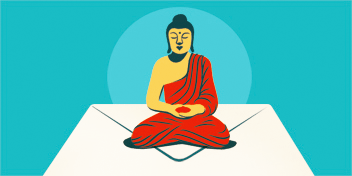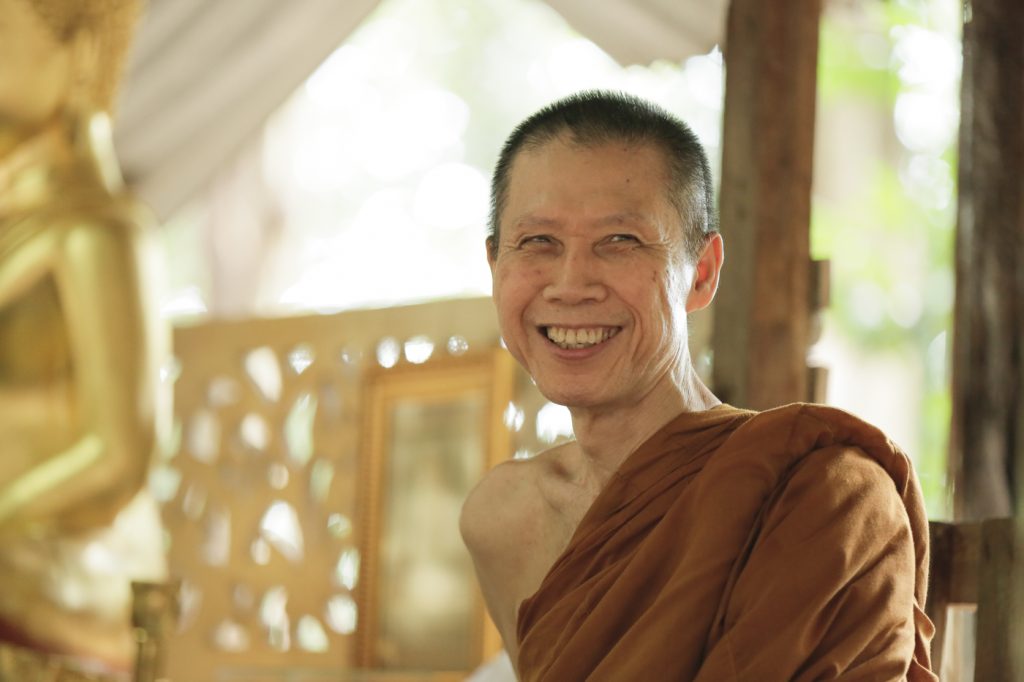While some dhamma teachers go to great lengths to promote their teachings—visiting different temples and monasteries around the world and speaking before vast crowds—others focus solely on practicing and living in accordance with the dhamma. Phra Ajahn Suchart Abhijāto, a teacher in the Thai Forest Tradition, sits firmly within this second group.
Born in 1947, Ajahn Suchart was raised by his grandmother in rural Suphan Buri, just northwest of Bangkok. Though his family was Buddhist, he was not raised religious, and even considered converting to Christianity while attending a Seventh-day Adventist elementary school (the administration offered half-price tuition for students who converted). His interest in the dhamma began at age 12, when he attended a funeral service for a classmate’s brother who had drowned: “My observation at that event was that this is how we would all end up one day, even my parents,” he writes in his autobiography. “When I looked at it, it was like bringing up an old memory that said, ‘This is the truth.’”
Ajahn Suchart went on to study civil engineering at California State University, Fresno, where he honed his English skills before returning to Thailand. While running a beachside ice cream shop in Pattaya, a tourist gave him a book that changed his life: an English translation of The Three Basic Facts of Existence I: Impermanence (Anicca). He eagerly wrote to the publishers requesting more reading materials and was sent a copy of the Satipatthana Sutta, or “The Discourse on the Establishing of Mindfulness,” which he studied and chanted diligently.
With his practice developing, Ajahn Suchart left his job to meditate full-time, living frugally off of his modest savings. A year later, Ajahn Suchart decided to ordain—but first, he’d have to figure out where, and under whom. Looking for a secluded forest monastery that valued meditation over scriptural study, Ajahn Suchart used Jack Kornfield’s guidebook to Thai monasteries to help narrow his search.
In 1975, Ajahn Suchart ordained at Wat Bowon in Bangkok, but he didn’t stay for long. His preceptor allowed him to leave the temple to study under the Forest Tradition teacher Luangta Maha Bua, deep in the northeastern countryside, where he stayed for nine years. In 1983, he found his way to Wat Yansangwararam—a large temple under royal patronage in Chon Buri, a coastal district southeast of Bangkok—where he has lived and taught ever since.
Like many Thai Forest teachers before him, Ajahn Suchart eschews scriptural study and places emphasis on meditation, including concentration practices like anapanasati (mindfulness of the breath) and repeatedly chanting Buddho (“Buddha”) as a mantra. “Dhamma that comes from just studying is different from Dhamma that comes from meditation practice,” Ajahn Suchart writes. “We call Dhamma that is the result of meditation practice ‘genuine Dhamma.’ ”
“I never laid out a plan or my life’s goal.… My destination is the coffin. How I get there is another matter.”
Every Saturday, Sunday, national holiday, and Observance day, Ajahn Suchart gives a dhamma talk outside his kuti (meditation hut). Some of the talks are recorded and distributed freely on his website, along with his books. In addition to his work at the monastery, Ajahn Suchart also hosts weekly Zoom meetings to answer questions in Thai and English for domestic and international audiences alike. But beyond these brief windows of communication, Ajahn Suchart chooses not to interact with the outside world, spending most of his time practicing instead. “When the day’s Dhamma talk is over, my day is done. I do not further engage with anyone,” he writes.
Despite receiving numerous offers to travel and teach abroad, Ajahn Suchart seems content doing exactly what he’s doing, exactly where he is. “I never laid out a plan or my life’s goal.… My destination is the coffin. How I get there is another matter.”
Visit phrasuchart.com for more on Ajahn Suchart, including his free books and dhamma talks.
Q: How do you overcome fear?
By teaching yourself the truth of the three characteristics: anicca (impermanence), dukkha (suffering), and anatta (nonself). When you know that you will die one day, you will not be afraid. We are afraid because we want to live forever. We don’t want to die. We cannot accept the truth. Once you see that life is like the rising and setting of the sun, you will not be afraid of dying; it is like the setting of the sun. You have to teach yourself all the time that one day you will die, using this as your meditation object. It will make your mind calm and peaceful.
Monks live in the forest in order to be close to life-threatening situations that will spur us to let go of our attachment to our bodies. When we have truly let go, we will not be affected by whatever happens to the body. It’s better to live without fear for one day than to live with fear for a hundred years, because fear is very damaging to the mind. You can get rid of fear by accepting the truth through the practice of meditation.
You will need a calm mind to reflect on this truth. If your mind is not calm, you will be prevented by your aversion from contemplating this truth. Aversion is delusion’s protective mechanism, but the truth will liberate you from it.
You must first calm your mind by concentrating on your breathing. Once you have achieved some calm, you can then contemplate the three characteristics of existence, the fact that you will die one day. You may be able to do this for a while. But eventually, the calm will disappear and the delusion will come back, bringing with it an aversion to the truth. You must then meditate to calm your mind again. When the mind becomes calm, you can then return to contemplating impermanence. Go back and forth like this until the truth sinks deeply into your mind, and you will find that accepting it is more beneficial than denying it.
Denial of the truth will always cause you to be afraid. But once you have accepted it, you will never be afraid. That’s all there is to it. The problem is in your mind. You can’t change external things. Whether you think about it or not, you will die anyway. But by thinking about it and accepting it, you will get rid of your fear; if you don’t think about it and deny it instead, you will always be afraid.
◆
From Dhamma for the Asking Volume 2 by Ajahn Suchart Abhijāto.
Thank you for subscribing to Tricycle! As a nonprofit, we depend on readers like you to keep Buddhist teachings and practices widely available.

